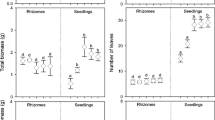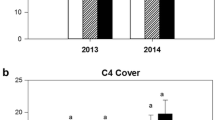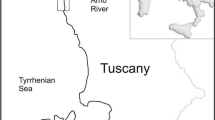Abstract
Intertidal wetlands provide examples of plants whose performance varies in response to resource (elevation) gradients, such as light, that are primarily determined by differences in tidal flooding. The spatial distribution (using Thiessen polygons to delineate neighborhoods) and performance (ramet height, weight, basal perimeter, photosynthetic area and inflorescence weight) of Scirpus americanus Pers. ramets were measured for three plots in each of the high and low elevation extremes of a resource gradient on an intertidal marsh of the Fraser River Delta, British Columbia, Canada. Most neighborhood polygons in both sites were six-sided and their frequency exceeded that expected for a Poisson distribution (i.e., complete spatial randomness). The frequency distributions of polygon shapes between low and high marsh sites were not significantly different but there were more five-sided polygons than expected in the high marsh. Two-way ANOVA for polygon area revealed significant differences between sites (p < 0.001, high marsh polygons ∼40% the area of those in the low marsh and with significantly less variability) and shape (p < 0.001, area increases with increasing number of neighbors) but the interaction effect was not significant (p= 0.10). There were no significant correlations (p > 0.05) between polygon area and ramet performance except for one high marsh plot that had significant (p < 0.01) positive correlations for polygon area and ramet photosynthetic surface area, weight and basal perimeter. Moran’s I and Geary’s C indicated that there is generally no spatial autocorrelation for polygon shape or ramet performance as only one plot in the high marsh had a significant (p= 0.009) negative autocorrelation for ramet height. Nearest neighbor analysis revealed a clumped distribution of ramets for two low marsh and one high marsh plot; ramets in the three remaining plots were distributed randomly. Ripley’s K revealed that ramet distributions were evenly dispersed at spatial scales of ∼2 cm for one plot in the high marsh and at ∼12 cm for one plot in the low marsh. We conclude that the overall lack of an even distribution across this resource gradient may be due to a heterogeneous environment at a scale of centimeters, asynchronous shoot emergence throughout the growing season, and disturbance by grubbing geese.
Similar content being viewed by others
References
Adachi N., Terashima I. and Takahashi M. 1996. Mechanisms of central die-back of Reynoutria jopinca in the volcanic desert on Mt. Fuji. A stochastic model analysis of rhizome growth.Annals of Botany 78: 169–179.
Aguilera M.O. and Lauenroth W.K. 1993. Neighborhood interactions in a natural population of the perennial bunchgrass Bouteloua gracilis. Oecologia 94: 595–602.
Antonovics J. and Levin D.A. 1980. The ecological and genetic consequences of density dependent regulation in plants. Annual Review of Ecology and Systematics11: 411–452.
Barlow G.W. 1974. Hexagonal territories. Animal Behavior 22: 876–878.
Bazzaz F.A. 1996. Plants in Changing Environments: Linking Physiological, Population, and Community Ecology. Cambridge University Press, Cambridge.
Bell A.D. 1979. The hexagonal branching pattern of rhizomes of Alpinia speciosa L. (Zingiberaceae). Annals of Botany 43: 209–223.
Buckley P.A. and Buckley F.G. 1977. Hexagonal packing of royal tern nests. The Auk 94: 36–43.
Burton B.A., Hudson R.J. and Bragg D.D. 1979. Efficiency of utilization of bulrush rhizomes by lesser snow geese. Journal of Wildlife Management 43: 728–735.
Cain M.L. and Cook R.E. 1988. Growth in Medeola virginiana clones. II. Stochastic simulation of vegetative spread. American Journal of Botany 75: 732–738.
Callaghan T.V., Svensson B.M., Bowman H., Lindley D.K. and Carlsson B.A. 1990. Models of clonal plant growth based on population dynamics and architecture. Oikos 57: 257–269.
Cook R.E. 1988. Growth in Medeola virginiana clones. I. Field observations. American Journal of Botany 75: 725–731.
DeLaune R.D., Reddy C.N. and Patrick W.H. Jr 1981. Accumulation of plant nutrients and heavy metals through sedimentation processes and accretion in a Louisiana salt marsh. Estuaries 4: 328–334.
Firbank L.G. and Watkinson A.R. 1987. On the analysis of competition at the level of the individual plant. Oecologia 71: 308– 317.
Haase P. 1985. Spatial pattern analysis in ecology based on Ripley's K-function: Introduction and methods of edge correction.Journal of Vegetation Science 6: 575–582.
Hara T. and Wyszomirski T. 1994. Competitive asymmetry reduces spatial effects on size-structure dynamics in plant populations.Annals of Botany 73: 285–297.
Harper J.L. 1985. Modules, branches, and the capture of resources.In: Jackson J.B.C., Buss L.W. and Cook R.E. (eds), Population Biology and Evolution of Clonal Organisms. Yale University Press, New Haven, pp. 1–33.
Herben T. and Hara T. 1997. Competition and spatial dynamics of clonal plants. In: de Kroon H. and van Groenendael J. (eds), The Ecology and Evolution of Clonal Plants. Backhuys Publishers, The Netherlands, pp. 331–357.
Hinde A.L. and Miles R.E. 1980. Monte Carlo estimates of the distributions of the random polygons of the Voronoi tessellation with respect to a Poisson process. Journal of Statistical and Computational Simulation 10: 205–223.
Hitchcock C.L., Cronquist A. and Ownbey M. 1969. Vascular cryptograms, gymnosperms and monocotyledons. In: Hitchcock C.L., Cronquist A., Ownbey M. and Thompson J.W. (eds), Vascular Plants of the Pacific Northwest. University of Washington Press, Seattle, pp. 1–914.
Hutchinson I. 1982. Vegetation-environment relations in a brackish marsh, Lulu Island, Richmond, B.C. Canadian Journal of Botany 60: 452–462.
Jonsdottir I.S. and Watson M.A. 1997. Extensive physiological integration: An adaptive trait in resource-poor environments? In: de Kroon H. and van Groenendael J. (eds), The Ecology and Evolution of Clonal Plants. Backhuys Publishers, The Netherlands, pp. 109–136.
Karagatzides J.D. and Hutchinson I. 1991. Intraspecific comparisons of biomass dynamics in Scirpus americanus and Scirpus maritimus on the Fraser River Delta. Journal of Ecology 79: 459–476.
Kenkel N.C. 1988. Pattern of self-thinning in jack pine: testing the random mortality hypothesis. Ecology 69: 1017–1024.
Kenkel N.C. 1993. Modeling Markovian dependence in populations of Aralia nudicaulis. Ecology 74: 1700–1706.
Kenkel N.C., Hoskins J.A. and Hoskins W.D. 1989a. Local competition in naturally established jack pine stand. Canadian Journal of Botany 67: 2630–2635.
Kenkel N.C., Hoskins J.A. and Hoskins W.D. 1989b. Edge effects in the use of area polygons to study competition. Ecology 70: 272–274.
Klekowski E.J. Jr 1997. Somatic mutation theory of clonality. In: de Kroon H. and van Groenendael J. (eds), The Ecology and Evolution of Clonal Plants. Backhuys Publishers, The Netherlands, pp. 227–241.
Kron P. and Stewart S.C. 1994. Variability in the expression of a rhizome architecture model in a natural population of Iris versicolor (Iridaceae). American Journal of Botany 81: 1128–1138.
Lechowicz M.J. and Bell G. 1991. The ecology and genetics of fitness in forest plants. II. Microspatial heterogeneity of the edaphic environment. Journal of Ecology 79: 687–696.
Levine N. 2000. CrimeStat Version 1.1: a spatial statistics program for the analysis of crime incident locations. Annandale, VA, USA.
Lovett Doust L. 1981. Population dynamics and local specialization in a clonal perennial (Ranunculus repens). I. The dynamics of ramets in contrasting habitats. Journal of Ecology 69: 743–755.
Mack R.N. and Harper J.L. 1977. Interference in dune annuals: spatial pattern and neighbourhood effects. Journal of Ecology 65: 345–363.
Mason H.L. 1957. A Flora of the Marshes of California. University of California Press, Berkeley.
Matlack G.R. and Harper J.L. 1986. Spatial distribution and the performance of individual plants in a natural population of Silene dioica. Oecologia 70: 121–127.
Richfield J. 1977. Geometrical patterns in nature. Journal of Ecology 73: 260–261.
Upton G.J.G. and Fingleton B. 1985. Spatial Data Analysis by Example.Point Patterns and Quantitative Data. Wiley & Sons, New York.
van Groenendael J.M., Klimes L., Klimesova J. and Hendriks R.J.J. 1997. Comparative ecology of clonal plants. In: Silvertown J., Franco M. and Harper J.L. (eds), Plant Life Histories: Ecology, Phylogeny and Evolution. Cambridge University Press, Cambridge, pp. 191–209.
Author information
Authors and Affiliations
Rights and permissions
About this article
Cite this article
Karagatzides, J.D., Manson, H.R. & Tsuji, L.J. Spatial distribution and performance of Scirpus americanus ramets across a temperate intertidal marsh resource gradient. Plant Ecology 169, 215–226 (2002). https://doi.org/10.1023/A:1026015218282
Issue Date:
DOI: https://doi.org/10.1023/A:1026015218282




